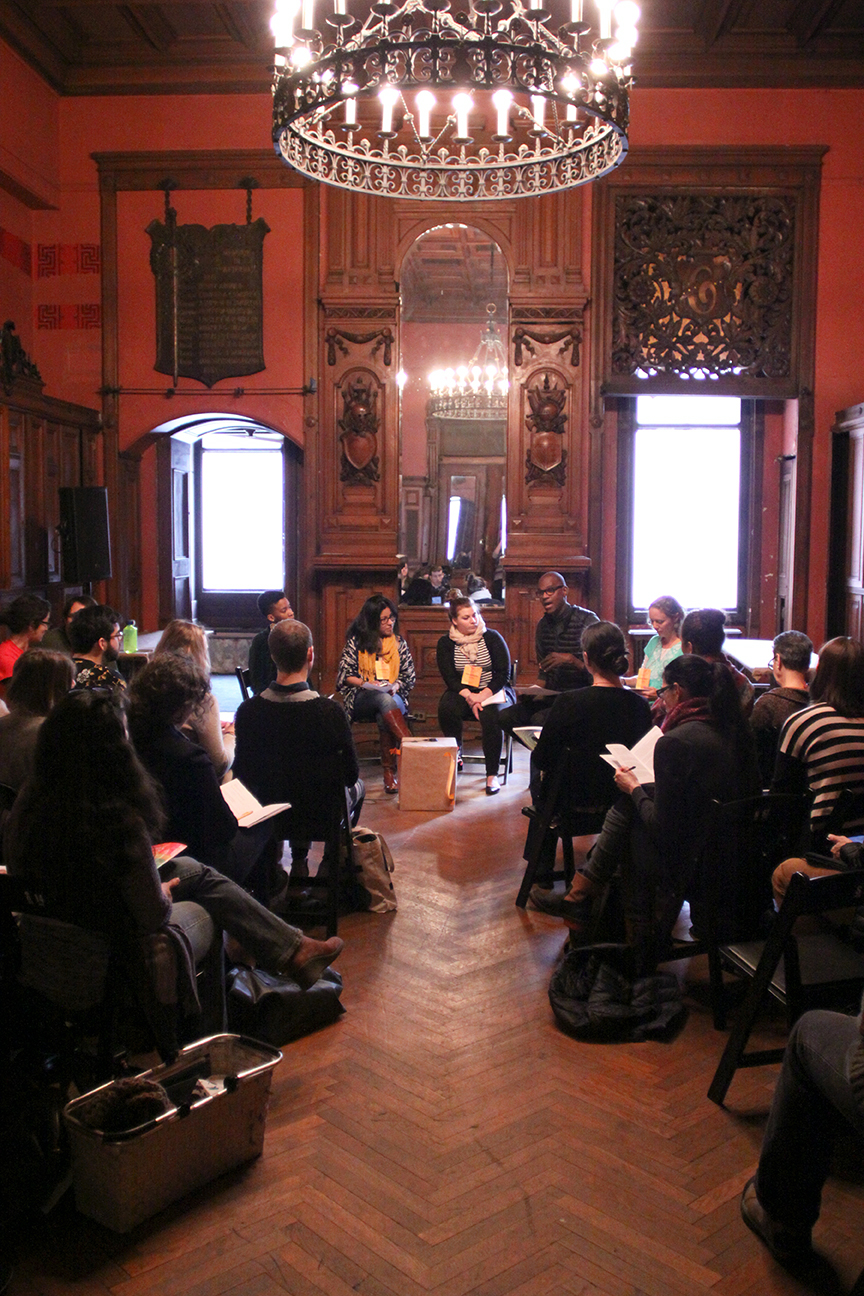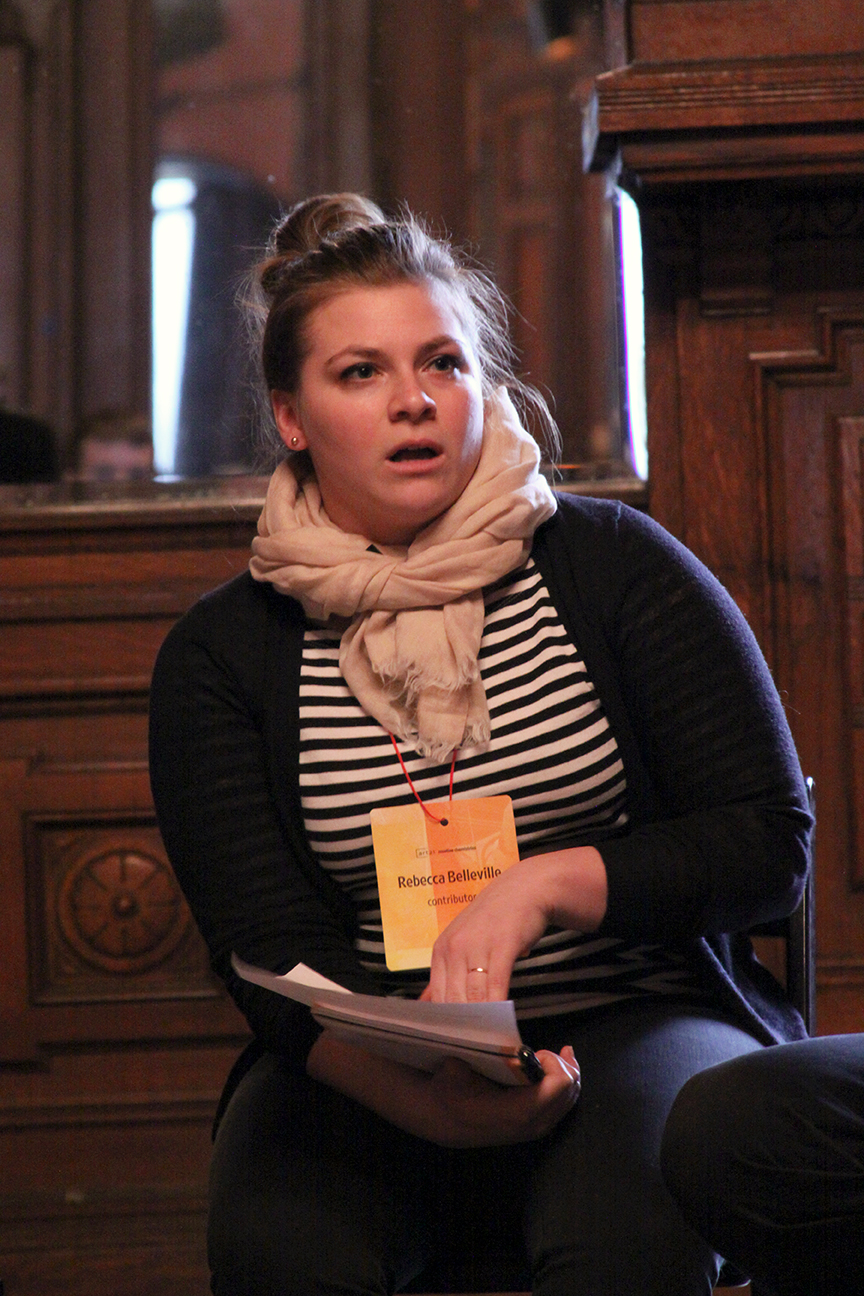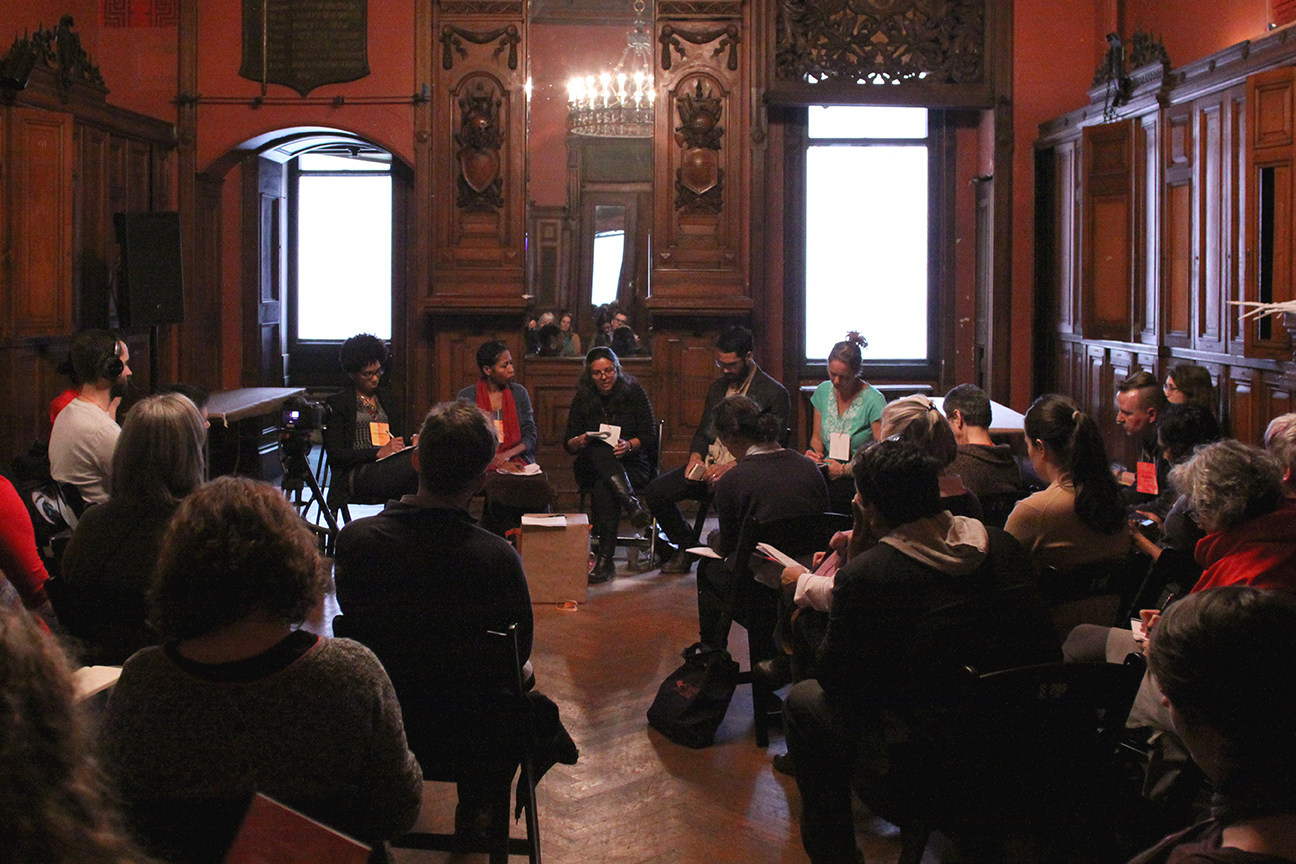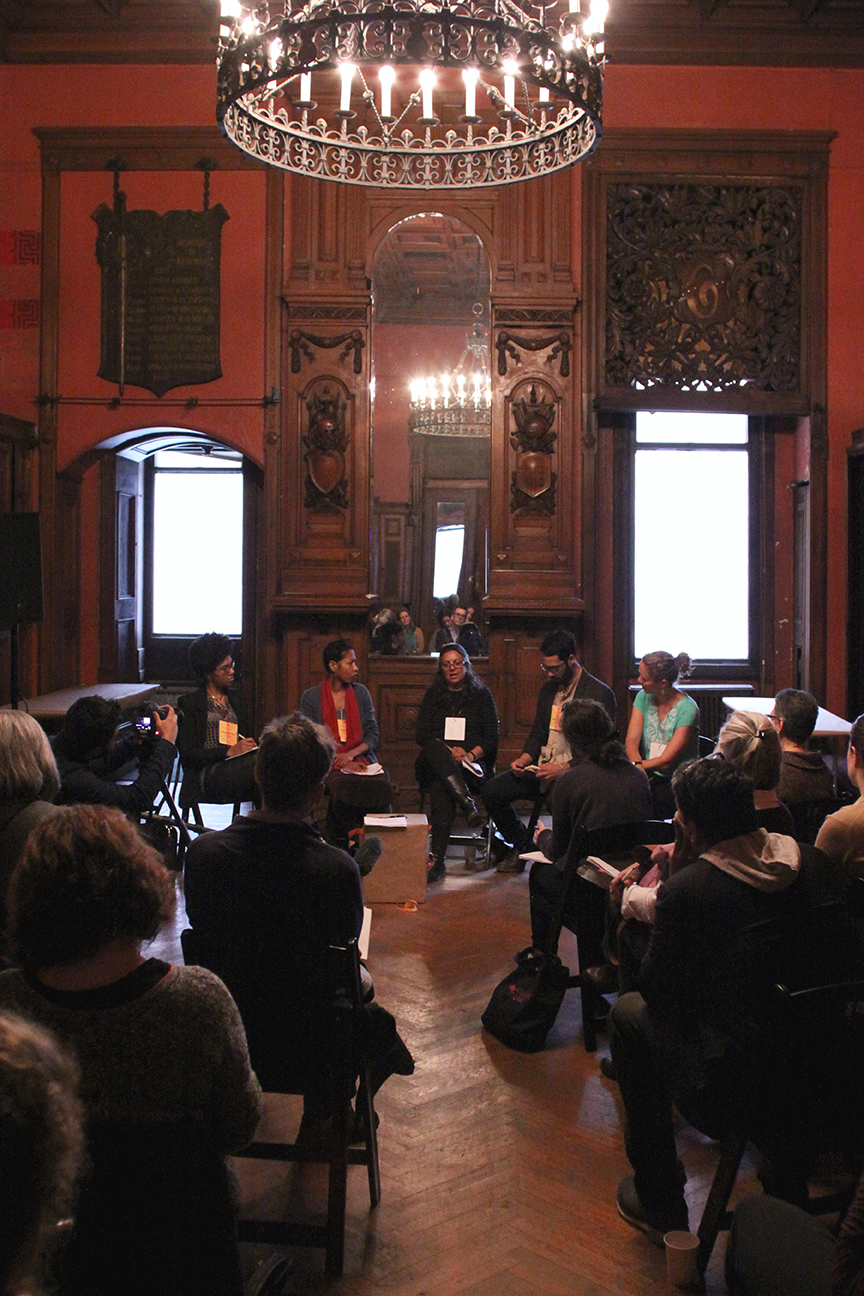Toward Equity, Access, and Social Justice
Dialogue
In these dialogues, a moderator sat down with four discussants to delve deep into specific issues surrounding contemporary art education. The audience and discussants were encouraged to visit two separate dialogues, so a different group of artists, art educators and art professionals contributed to the first and second parts of the discussion.
Toward Equity, Access, and Social Justice was moderated by Dr. Marit Dewhurst, Director of Art Education and Assistant Professor of Art and Museum Education at the City College of New York. She has worked as an educator and program coordinator both nationally and abroad in museums, community centers, juvenile detention centers, and international development projects. Her recent book, Social Justice Art: A Framework for Activist Art Pedagogy, highlights her research on youth activism in the arts.
Part 1
In the first session of Toward Equity, Access, and Social Justice, moderator Marit Dewhurst asked audience members for words and phrases about equity and social justice that interested them. Responses included “community,” “freedom,” “privilege,” and “hope for the future.” Panelists then responded to questions about equity, which sparked a conversation about the difference between deep engagement and token engagement, strategies for working with surrounding communities, and the barriers between the “real world” and the “art world.”
Discussants:
- Mark Bradford, Artist—Los Angeles, CA
- Raygine DiAquoi, Educational equity consultant—Boston, MA
- Rebecca Belleville, Art Educator, Baltimore Design School; ART21 Educator—Baltimore, MD
- Yvette Ramírez, Program Associate, The Laundromat Project—New York, NY
Risks of social justice
What are the unintended consequences of work towards social justice?
Mark Bradford: We have to be very aware of our biases when we start teaching. We can talk about social justice and ideas outside of the norm, but oftentimes, you’re dealing with students who have traditional viewpoints – especially teenagers – about gender, race, and sexuality. If you’re not careful, if you just demand that they have this postmodern social justice perspective, I think it can be very dangerous. It can be very alienating. I think it can create a lot of conflict and defensiveness, where they just shut down and give you what they think you want to hear.
Raygine DiAquoi: One of the things I do as a researcher… is I make my bias very clear, and I explain to the participants how that [bias] influences the way that I approach a project and see a project. And then I have them think about what kind of proclivities they bring to a particular project. I’m all for putting the biases on the table.
Fight the disease, not the symptoms
How can we move beyond addressing symptoms, to dismantling unfair systems?
Yvette Ramírez: The Laundromat Project brings artists and arts and culture into everyday spaces such as Laundromats, sidewalks, communities and festivals. The heart of that are the artists that we work with: teaching artists, the artists in residence, and our fellows. And it’s really important that… there’s always time for research and there’s also time for listening. The ideas might be amazing and brilliant, but always making sure that you’re having conversations and you’re there [with the community] – that takes time.
Rebecca Belleville: We’re not looking at the ways in which our poorer students and our students of color have systematically been hurt.
I think the first step is educating ourselves, especially as white educators. We have a majority white population teaching in schools of color. This is an issue that’s historical and that’s not being addressed: white savior complex, the missionary complex. We’re not talking about these things. What does that do in terms of internalizing racism with our students? If we’re not addressing the systems, and we’re not addressing who we are and what our place is in this, we’re never going to dismantle anything, because we’re barely addressing the symptoms.
Raygine DiAquoi: I use a lot of visual elicitation in my work, which can be participant driven or teacher/researcher driven. If it’s participant driven, the students are taking the pictures. If it’s researcher driven, you’re presenting them with pictures, images, video, etc. – media that’s visual. The idea is to use these pictures as a way of talking about a certain topic. For example, one way that art can enable people to move from symptoms to systems, or dismantling systems.
Let’s say we want to talk about “food deserts.” You can have students take artistic, beautiful photographs of the lack of vegetables or the overabundance of Doritos and hot chips, and you can bring that together and have people talk about the differences. Or you could go to another neighborhood and have them take pictures of some of the differences in produce that exist. Yes it’s beautiful, and you can have an exhibit, but you’re also going to stir up a wonderful conversation, talking about things or seeing things in a way that they might not have seen before.
Encouraging engagement
What are models for positive student engagement and agency?
Raygine DiAquoi: YPAR is Youth Participatory Action Research. The youth dictate the topic that they want to explore through art. You have them thinking about the dimensions of that topic, and how they want to use art to explore it. It’s not token engagement because it’s not a teacher saying, “We should talk about ‘food deserts.’” You take a vote as a collective about what’s important to them as youth in their community…
I do want to add that this idea of student-driven inquiry, or the generative process of making in the classroom, seems to be very successful in research studies of small sample groups and afterschool programs. It’s a much different beast when you’ve got 30-40 kids, three to seven times a day. It looks very different when you’re trying to regulate that in a classroom, and then you’re trying to assess for that. So this is the question that I’m asking myself all the time, and my teachers are asking themselves all the time: How do we get authentic making in a classroom when things are regulated?
Yvette Ramírez: One of the things we’ve been doing for the last year has been a course called “Print Change,” which is open to middle-school students and high-school students in Laundromat Project neighborhoods. We teach students the techniques of silkscreening and linocutting, but we definitely link it to how it’s been used in social movements, in terms of civil rights… The hope is to create work that responds to what they want to talk about in their communities. For example, the cops are constantly harassing my fellow students, or men are harassing me on the streets. We’ve done two iterations in Harlem responding to gentrification and police brutality.
What is meaningful community engagement?
Rebecca Belleville: I keep thinking about this idea of engagement with the community and how that is radical in and of itself. Historically, we have done exactly what LaToya Ruby Frazier described, walking by the library every single day and not realizing that you have permission to enter. That’s the way I feel a lot of parents feel with me as a white educator, that they don’t even have permission to interact with me, to be in my classroom. It’s important to set the stage to be open, to have this dialogue, to create a welcoming environment so that parents [and family members] don’t feel uncomfortable… So everyone feels welcome… and that art is not exclusionary – it is participatory.
Mark Bradford: When I started the foundation Art + Practice and collaborated with the social service agency and foster youth, it completely changed the organization. Immediately, it could not be either/or. It was social service and contemporary art, and it had to navigate both. If we would do more partnering outside our field, it would change the reach. Why not partner with senior centers or abuse shelters? There are so many things that contemporary art can partner with. I mean real collaborations, real partnerships. That in and of itself is radical. We constantly are asking everyone to come to our museums, come to our classrooms, come to us. We never go to them. And that can change the game.
Part 2
In the second session of Toward Equity, Access, and Social Justice, moderator Marit Dewhurst asked the audience for words and phrases about the conversation on access and equity. Responses included “opening up to new perspectives and paradigms,” and “a desire to serve the community.” Panelists then introduced their work and the issues they’re grappling with, both practical and ethical. The conversation that followed explored making hidden narratives visible, the act of listening as an activist practice, and alternative strategies for establishing equity.
Discussants:
- Dipti Desai, Associate Professor and Director of Art + Education Programs, New York University—New York, NY
- Fadwa Abbas, Independent Educator—New York, NY
- José Serrano-McClain, Organizer, Educator, Artist—New York, NY
- LaToya Ruby Frazier, Artist—Chicago, IL
Bringing social justice to art education
What is social justice art education?
José Serrano-McClain: [At the Queens Museum] we decided to understand what our role could be as an art institution that also is aware of the political context. In Corona we have the most overcrowded schools in the city. We have transportation issues – mainly lack of transportation infrastructure. Who gets to decide the future of public park spaces?
In our intervention [we looked to] create a learning framework. To host an experimental school that invites community members to understand the spatial and political issues, but also understand the design issues. The most important aspect was to turn participants, in this first iteration of the design school, into ambassadors that can bring their neighbors into the conversation.
Dipti Desai: I have been thinking through some of the key aspects of doing [artistic activism] work, and so I’m going to raise more questions than answers. The four issues that I think get played out are firstly, aesthetics: What do we mean by aesthetics in this kind of work? Do we need to change the way we think about what aesthetics are and what they mean? Ethics: What are the ethics of doing this work? What is the power relationship between the communities in which we work and ourselves? Efficacy: Does it work and does it matter? As artists do we need to know that it works? And if we do want to know if it works, have we really created structural change? And education: Is this kind of artistic practice pedagogical? And what does it mean for pedagogy to be an artistic activist project or endeavor? I’m grappling with these issues with students [at NYU] as we work on projects. Many of them have been tactical, but we have started some long-term projects with the goal of being sensitive to what [the communities] need and how we partner with them.
Fadwa Abbas: I was lucky enough to be living in Arizona when Jan Brewer passed that SB 1070 law. I immediately became involved even though I’m not Mexican-American or Mexican or Chicano, and I don’t speak Spanish. But that was a moment for me in terms of understanding what activism is. I saw that the people who were out in the streets weren’t intellectuals, weren’t professors, weren’t people with college degrees; they were mothers with babies who worked in factories for $5 an hour. What was fascinating was that a lot of that conversation was happening through art. There was a lot of imagery, a lot of beautiful expression happening – not in books or journals or conferences, but literally people creating artworks and going to their community centers and putting it out there.
LaToya Ruby Frazier: Since I was a teenager I have been using the visual language of the camera to fight back against my own plight in poverty. This is how it began for me. In terms of speaking to a group of educators, I was a kid when I started making my art, and I couldn’t articulate or understand why my grandmother and I lived in this area [of Braddock, Pennsylvania] called The Bottom, next to the steel mill, next to all the truck traffic and pollution. From The Bottom as you go up past Braddock Avenue, you go up a hill and the higher you lived up that hill meant the better socio-economic status you had. So I turned to art. I turned to the camera to start to visualize it.
I made this book called The Notion of Family that just came out with Aperture Foundation this fall. Now I have this book that is a human document of 12 years of all this injustice. But now what I’m trying to do is figure out how to put it to use. Do I use it to deal with issues concerning black women, with fighting drugs, or discrimination in the healthcare system? Do I use it to fight against how we’re being dispossessed continually in Braddock? Do I use it to say that this is the counter-narrative, and I’m done? This is my counter-narrative. I’m at that fork in the road where I really have to figure that out. I want to empower people who are there.
Instituting equity
What are strategies for establishing social, cultural and political equity?
Dipti Desai: There are missing narratives. In each historical period, there have been groups of people and events that have been rendered invisible. It’s those erasures that LaToya’s work is bringing to the forefront… [History] is one-dimensional in its portrayal of a place that’s always complex. There are always multiple histories and stories…
One of the things that GOLES [Good Old Lower East Side] has asked us to do is to help generate the history of Latino activism that is very much part of the Lower East Side. There’s a lot of history about Jewish activism, but none about the Latino and Latina community. They said, we need to know about that so we can learn from what’s been done already, so we’re not always reinventing the wheel to move forward.
Fadwa Abbas: For me it’s become really important the longer I live in this country, the further away I am from my little house in Sudan and my experience there, to understand that there’s this vast abyss of darkness in terms of our understanding of what people’s lives are like elsewhere. And in that darkness we assume that their lot is worse than ours. There is a narrative of benevolence, that we have something to teach them. They don’t have something to teach us. When we say education, that’s not just education of “them.” It’s also educating ourselves in terms of all of these ways of being and existing.
LaToya Ruby Frazier: Look for the stories that aren’t being told. As an educator, you can always assume and know that this is the major story; this is the main event, the headliner. But there must be a million others. How do we find the people who aren’t being given that platform or opportunity and get them in front of our students and into the classrooms?
José Serrano-McClain: I began by talking about a community design school to address the issues of Flushing Meadows Corona Park. We [at the Queens Museum] framed this in partnership with the Parks Department so that the Parks Department had to develop the curriculum with us. That means that the Parks Department really are the students, right? It’s not radical education if it doesn’t involve the learning of the institutions. The institutions must change.
Moderator’s dialogue reflection
I was really struck by the different tenor of each conversation since I think it represents one of the challenges of the intersection of social justice and art education. For me, the first conversation – for whatever reason – felt tied to on-the-ground tensions. For example, what happens when a young person directly raises questions about race? Or how might we actually perpetuate systems of inequality by dropping into a community? We talked about specific strategies for working in ways that lift up the multiple perspectives of all participants so that artists and community members are working alongside each other to dismantle the injustices they identify. From taking the time to actively listen, to engaging in collaborative research, the teaching tools we discussed highlighted the critical value of working in partnership with communities.
The second conversation focused more on the framing of art that’s made for social change – what we call it, how we critique or even identify it, and how it fits within conversations about aesthetics and change in general. In this conversation I was struck by how each person linked their views to their own life experiences (where they grew up, how they’ve moved through the world). These life experiences shape how they view the role of art in social justice work – from seeing it as a tool for making untold stories visible or for engaging groups in conversation. Each vantage point lent a slightly different framing to the work, making me wonder about the powerful role of context in social justice art.
– Marit Dewhurst
Saturday, February 21st 2015
11:45 a.m. / 1:30 p.m.


We have to be very aware of our biases when we start teaching… Oftentimes, you’re dealing with students who have traditional viewpoints – especially teenagers – about gender, race, and sexuality.
If you’re not careful, if you just demand that they have this postmodern social justice perspective… it can create a lot of conflict and defensiveness, where they just shut down and give you what they think you want to hear.
— Mark Bradford






Now I have this book that is a human document of 12 years of all this injustice. But now what I’m trying to do is figure out how to put it to use… I’m at that fork in the road where I really have to figure that out. I want to empower people who are there.
— LaToya Ruby Frazier

There are missing narratives. In each historical period, there have been groups of people and events that have been rendered invisible…
History is one-dimensional in its portrayal of a place that’s always complex. There are always multiple histories and stories.
— Dipti Desai


